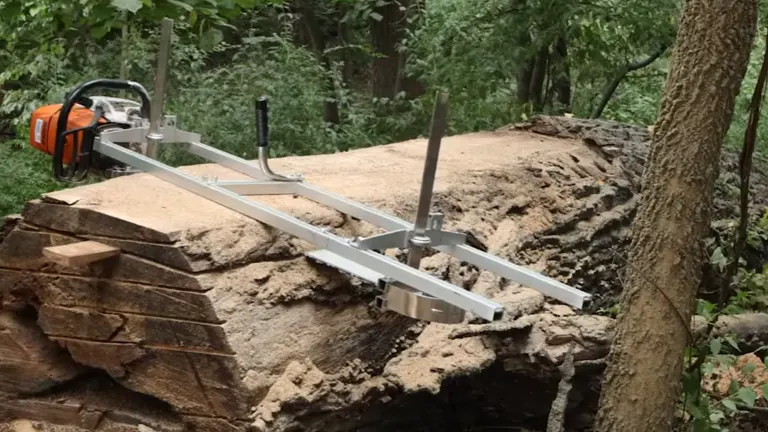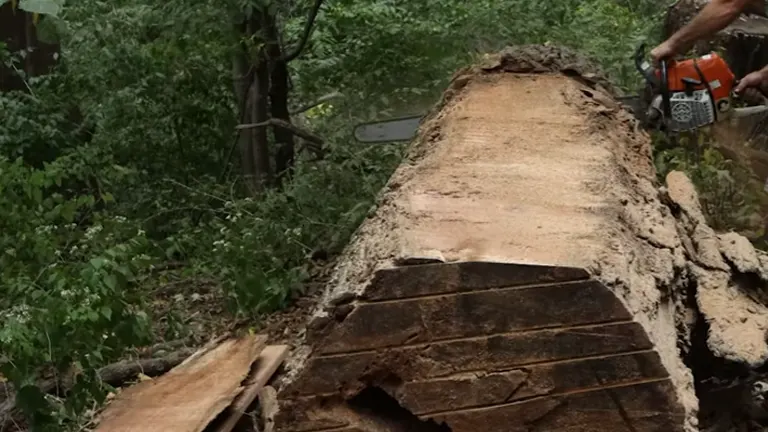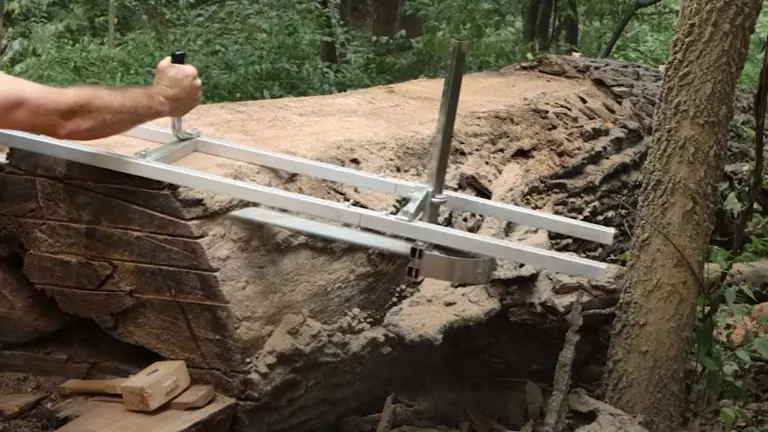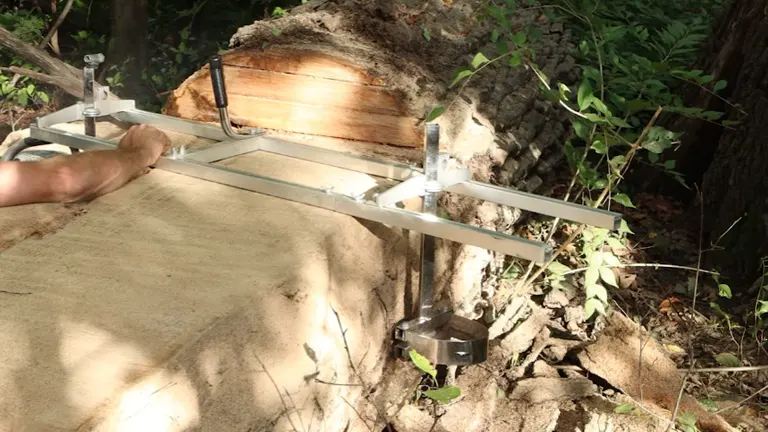Beginner’s Guide to Chainsaw Milling: Tips, Tricks, and Techniques
- April 15, 2024
- 1 comment
Explore chainsaw milling with our guide on tips, tricks, and techniques for woodworkers looking to mill their own lumber affordably and flexibly.

For many woodworkers, the ability to mill their own lumber is a key skill they aspire to master. While researching online, you’ll discover a diverse range of milling equipment. However, the initial cost can be daunting. Over the past year, I have explored various milling methods including using a Woodmizer, constructing my own wooden bandsaw mill, and most recently, experimenting with a Stihl 661 chainsaw mill. Among these, I’ve found chainsaw milling, especially for large logs, to be the most flexible since it allows you to bring the mill to the log rather than the other way around.
Choosing the Right Equipment in Chainsaw Milling
The cornerstone of effective chainsaw milling is selecting the right chainsaw. Although I’m partial to Stihl, the brand is less important than the chainsaw’s power relative to the log’s size.

The Stihl 661 Magnum has been my go-to, equipped with a 42-inch bar and a ripping chain, it comfortably handles slabs just over three feet wide. This chainsaw strikes an excellent balance between power and affordability, costing just under $1,000. While the more powerful Stihl 881 was an option, it didn’t seem worth the additional $1,200 for just an extra horsepower.
Setting Up Your Mill
I opted for a budget-friendly mill from Amazon that mimics the Granberg Alaskan Mill. Although it’s a non-branded version, it functions adequately for beginners. This mill came with a top guide, which I found to be less reliable.

To improve stability and ensure higher-quality cuts from the start, I replaced the original top guide with a sturdier 2×12 plank. This adjustment can significantly enhance your milling experience, making it less frustrating and ensuring better quality slabs.
Practical Tips and Advanced Techniques
When starting out, it’s essential to consider how you’ll use the milled wood. For the initial cuts, a flat reference on top of the log is crucial. The mill’s top guide, included with many models, is meant to help with this, but I found creating a custom guide using a 2×12 plank provided a better solution. Once the first flat slab is cut, it can serve as a reference for subsequent cuts.

If the standard milling width isn’t sufficient, one advanced technique is to modify the mill to extend its capacity. I achieved this by removing unnecessary parts and customizing the setup to fit larger logs. This can be a game-changer for those looking to mill particularly large pieces of timber.
Common Challenges and Solutions
One common issue in chainsaw milling is the potential for the saw to bind in the cut. To address this, well-placed wedges can help maintain a clean cut through large logs.

Additionally, if the bar begins to wear, it’s possible to adjust the milling setup to reduce strain on the equipment. This involves careful placement and minimal pressure to avoid damaging the chainsaw’s sprocket.
Advanced Techniques for Experienced Chainsaw Millers
If you’re already comfortable with basic chainsaw milling and ready to enhance your milling efficiency or take on more challenging projects, these advanced techniques can elevate your skills and results:
- Progressive Cutting Techniques
- Plunge Cutting: For making deep cuts directly into the middle of a log without starting at the edge. This technique is essential for creating openings in large logs or removing large sections in a single pass.
- Quarter-Sawing: This method involves sawing the log into quarters to maximize the appearance and durability of the wood grain. It’s more labor-intensive but yields wood that’s less prone to warping and more aesthetically pleasing.
- Using Auxiliary Oiling Systems
- Enhance your chainsaw’s bar oiling by adding an auxiliary oiling system to ensure consistent lubrication, especially during extended cuts. This can prevent overheating and prolong the life of your chain and bar.
- Jig and Fixture Enhancements
- Build or invest in custom jigs and fixtures that allow for more precise cuts. For example, adjustable log stands or rail systems can provide a more stable and accurate cutting environment, improving the quality of your milled lumber.
- Hybrid Milling Techniques
- Combine chainsaw milling with other forms of saw milling. For instance, use a chainsaw mill to initially size down a log, then finish with a band saw mill for finer, more controlled cuts. This can be particularly useful for producing furniture-grade lumber.
- Stress Relief Cuts:
- Before making your final cuts, incorporate stress relief cuts into large logs. These cuts can prevent the wood from pinching the saw blade and reduce the internal stress in the milled lumber, minimizing warping as the wood dries.
- Advanced Maintenance Skills
- Sharpen your chains specifically for ripping cuts, which require a different angle than standard cross-cut chains. Learning to customize your chain’s teeth can greatly affect the efficiency of your cuts.
- Regularly check and adjust the tension in your chainsaw bar to ensure optimal performance and prevent sagging during cuts, which can affect the straightness and quality of your mill.
- Utilizing Wedges and Straps
- Use wedges more strategically to control the direction and pressure of your cuts, especially in larger logs. This can help maintain consistent cutting speed and prevent the saw from binding.
- Employ ratchet straps or clamps to secure the log firmly to your milling setup, which can be crucial when dealing with irregularly shaped or unbalanced logs.
Conclusion
Chainsaw milling is a rewarding skill that allows woodworkers to produce their own lumber from large logs. With the right equipment and some modifications, it can be an economical alternative to more expensive milling methods. Whether you’re a seasoned woodworker or a novice looking to start milling, chainsaw milling offers a versatile and cost-effective solution. Remember, the key to successful milling is not just the equipment but also understanding how to adapt and optimize it to suit your specific needs.
FAQs
- What are the benefits of plunge cutting in chainsaw milling?
Plunge cutting allows for starting a cut anywhere on the log without the need to approach from the sides. This technique is particularly useful for creating interior cuts or extracting specific sections of a log without slicing through the entire piece. - Can quarter-sawing be done with a chainsaw mill, and what are its advantages?
Yes, quarter-sawing can be done with a chainsaw mill. This method produces lumber with a unique grain pattern that’s not only visually appealing but also more stable and resistant to warping compared to plain-sawn wood. - How does an auxiliary oiling system benefit chainsaw milling operations?
An auxiliary oiling system provides additional lubrication to the chainsaw bar and chain, which is crucial during long milling sessions. It helps reduce friction and heat buildup, thereby extending the life of the chainsaw components and improving cutting efficiency. - What types of custom jigs and fixtures can enhance chainsaw milling accuracy?
Custom jigs like log rotation fixtures and vertical cutting frames can greatly enhance precision. These setups stabilize the log, ensuring consistent thickness in slabs and reducing errors associated with manual handling. - Why are stress relief cuts important in chainsaw milling, and how are they performed?
Stress relief cuts help manage the internal stresses within a log that can cause the wood to pinch the saw or split during cutting. These cuts are strategically placed in shallow incisions made before the final cuts, reducing tension in the wood and minimizing potential deformities as it dries. - What specific sharpening techniques should be used for chains optimized for ripping through logs?
Chains used for ripping require a different tooth angle, usually around 10 degrees, compared to the standard 30 degrees for cross-cutting. This shallower angle helps the chain to efficiently pull itself along the length of the log, producing smoother cuts. - How do ratchet straps or clamps improve the milling process?
Ratchet straps or heavy-duty clamps secure the log firmly to the milling platform, preventing any movement during cutting. This stability is crucial for achieving uniform slab thickness and preventing accidents due to log shifts. - Is there a recommended method for adjusting the tension in a chainsaw mill setup?
The tension in a chainsaw bar should be checked and adjusted regularly to ensure it’s tight enough to prevent sagging but not so tight that it hinders the chain’s movement. Proper tension is critical for maintaining straight cuts and effective operation.
We hope this guide has sparked your interest and maybe even enhanced your chainsaw milling techniques! Have any tips or questions of your own? Share them in the comments below—we’d love to hear about your experiences and learn together. Don’t forget to share this guide with fellow woodworking enthusiasts!

David Murray
Forestry AuthorI'm David Murry, a forestry equipment specialist with a focus on chainsaw operation. With over 13 years of experience, I've honed my skills in operating and maintaining a wide range of machinery, from chainsaws to log splitters. My passion for the outdoors and commitment to sustainable forestry drive my work, which emphasizes safety, efficiency, and staying updated with industry advancements. Additionally, I'm dedicated to sharing my expertise and promoting environmental awareness within the forestry community.












Very interesting I live in Kentucky Appalachian Mountains hardwood capital of America. I'm semi retired and looking for a hobby and extra cash im going to build a sawmill and mill my own logs and lumber products especially for sale to make furniture projects etc
Michael Justice
June 16, 2024 10:39 pm